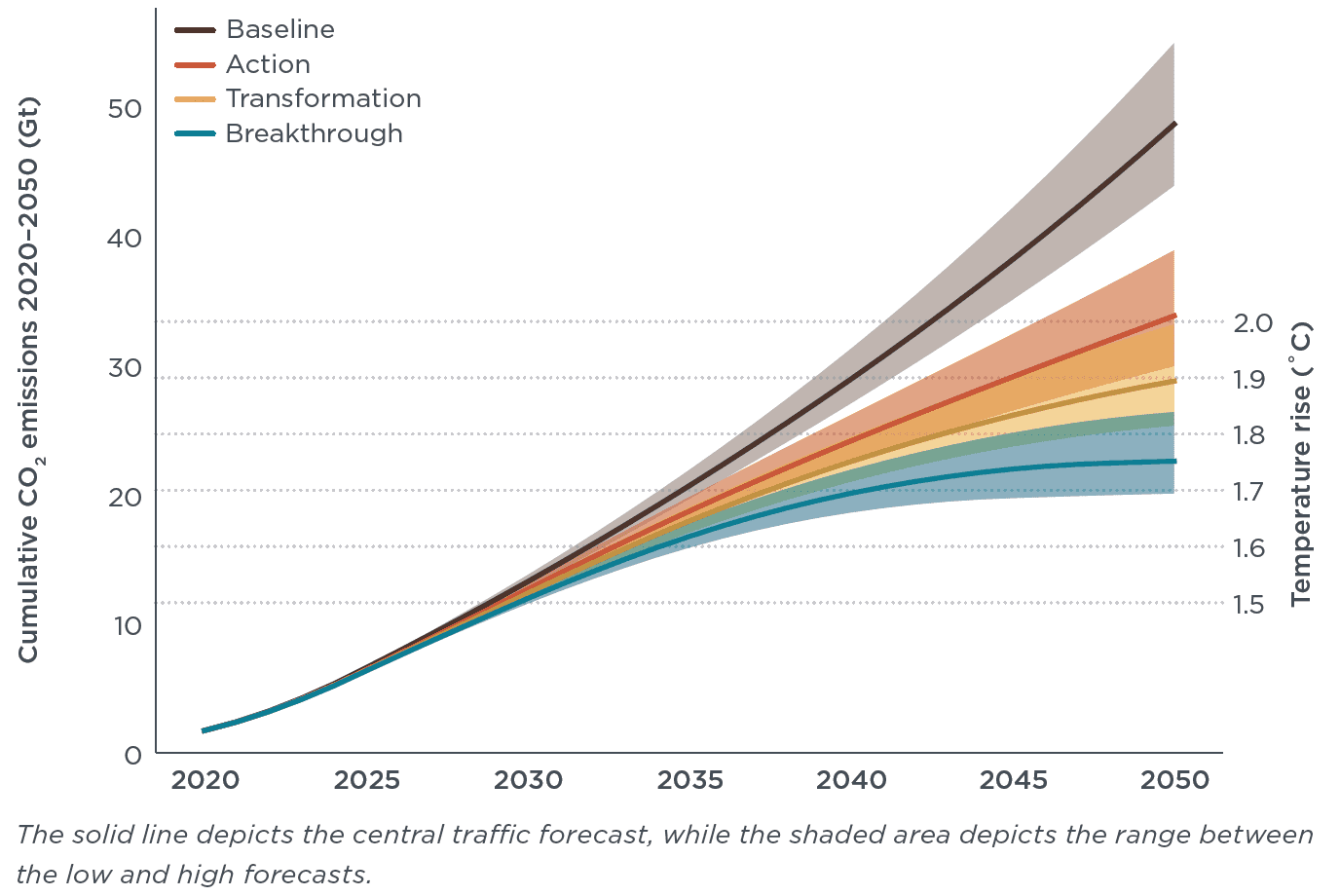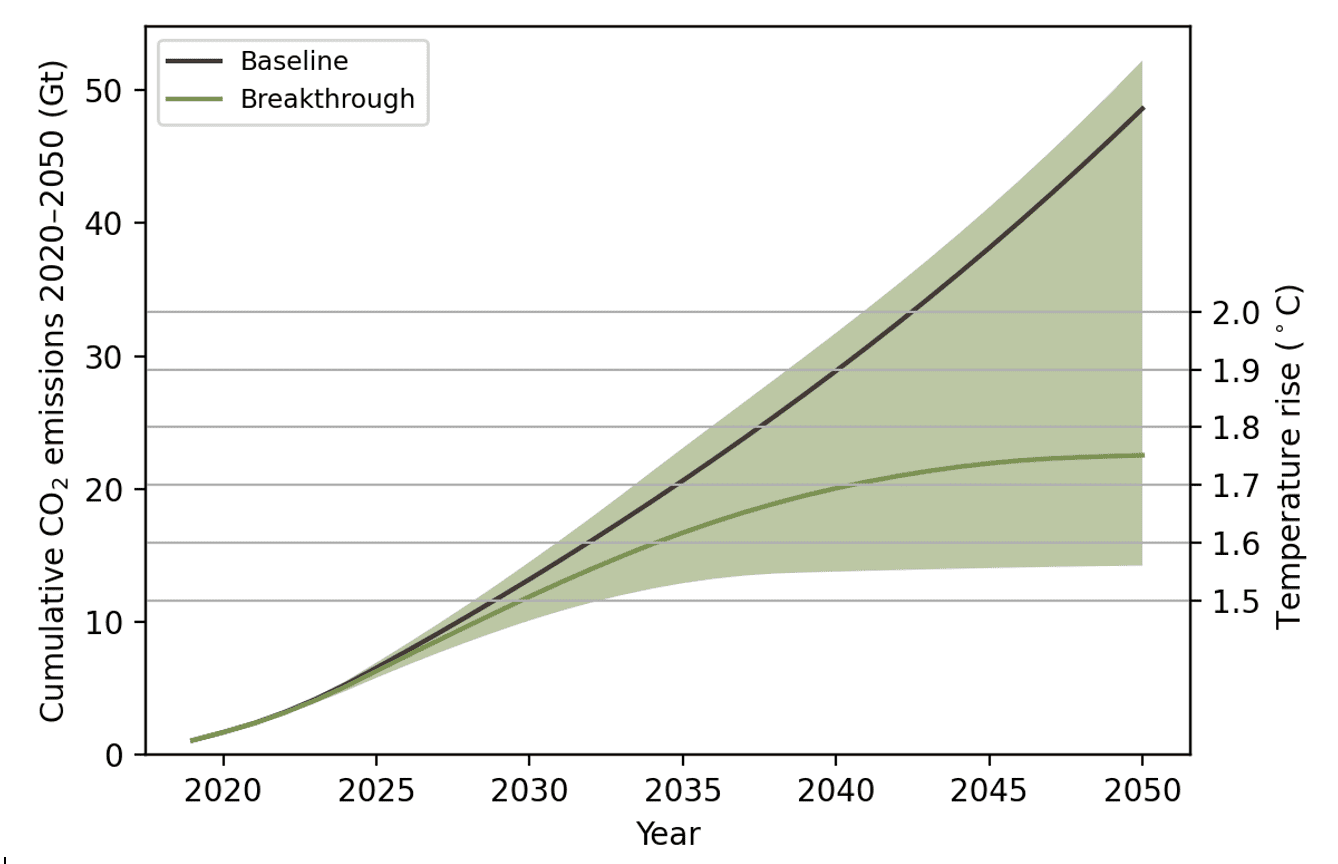CO2 emissions from commercial aviation: 2013, 2018, and 2019
Blog
The tortoise and the hare? The race to decarbonize aviation
Over the past century, the speed and convenience of aviation have spurred rapid increases in demand for air travel, while improvements in aircraft fuel efficiency have struggled to keep up. The result: growing emissions. From 1960 to 2018, global carbon dioxide (CO2) emissions from aircraft increased almost sevenfold, or 3.4% per annum (p.a.), and grew even faster from 2013 and 2019. Leading up to the COVID-19 pandemic, traffic expanded almost four times faster than fuel efficiency improved. Since 1960, only during economic recessions and the COVID-19 pandemic has traffic growth slowed enough for fuel efficiency to reduce absolute emissions—and then only briefly.
The mismatch between sprinting growth in air traffic and plodding gains in fuel efficiency might call to mind Aesop’s fable of “The Tortoise and the Hare.” In the story, a cocky rabbit challenges a slow but steady tortoise to a race. Far ahead in the competition, the bored rabbit lies down for a nap short of the finish line. As he snoozes, the plodding tortoise trudges past and wins the race. The underdog’s success prompts a question: Under what conditions will progress toward cleaner aircraft and fuels (the tortoise in our story) outpace market growth for air travel (our hare) to usher in an era of zero-emissions flying?
A popular topic in aviation research today is the potential for achieving net-zero emissions from aircraft, a goal consistent with the aims set by the Paris Agreement. In alternative emission scenarios modeled in ICCT’s most recent aviation report, the most ambitious—dubbed “Breakthrough”—posited that concerted action by governments and industry could cut cumulative, 2020 to 2050 CO2 emissions from the world’s airlines by more than half (green wedge in Figure 1). If airlines maintain their current share (2.9%) of global well-to-wake (WTW) CO2 emissions during that time, our Breakthrough scenario would be consistent with a 1.75°C temperature future (right scale).

Figure 1. WTW cumulative global aviation CO2 emissions by scenario and traffic forecast, 2020-2050 (Graver et al. 2022)
That’s good news! But the emissions trajectory of the Breakthrough scenario, with annual CO2 from aircraft peaking in 2025 and reaching near-zero levels in 2050, is not at all consistent with the galloping trend of aircraft emissions pre-COVID. Improvements in fuel efficiency, at about 2% annually under our Breakthrough scenario, continue to be slower than growth in traffic, which ranges from 2.2% to 3.7% p.a. in Breakthrough. In other words, consistent with the record of the past century, improvements in efficiency alone are too weak to offset travel demand and reduce emissions.
But the story shifts if we look beyond efficiency gains to changes in the fuel itself, that is, if aircraft shift from fossil fuels to sustainable aviation fuels (SAF)—a catchall term for alternatives to fossil jet fuel, most derived from biological or renewable energy feedstocks. In our Breakthrough scenario SAFs account for about 60% of all mitigation. Hydrogen, to be used in zero-emission planes (ZEPs), also plays a role, phasing in slowly starting in 2035 and growing to a maximum of 21% of fuel demand in 2050. In total, SAFs and ZEPs provide about two-thirds of the mitigation in the Breakthrough scenario. It’s as if our tortoise found, halfway through the race, a set of superfoods to propel him forward.
So the race to zero-emission aviation is less about the historical competition between traffic growth and fuel efficiency and more a new race between traffic and alternative fuels (with efficiency in a supporting role to help ensure that fuel demand doesn’t outstrip renewable energy supply). To be clear, this reframing does not immediately yield a more encouraging picture: SAF uptake remains negligible (0.05% of total fuel use) due to airlines’ reluctance to spend more on fuel. But that reluctance is likely to soften as governments develop mandates and incentives to push SAFs, supercharging emissions reductions from technology.
Market growth is important in this story, too, and here the range of possible futures is broad. At the very high end, aviation traffic could resume its pre-COVID breakneck growth rate and expand at 7% p.a. through 2050. Likewise, reductions in business and leisure travel in response to new videoconferencing technologies and climate concerns—shifts akin to the nap taken by the hare—could conceivably cap aviation traffic at 2019 levels. How would the renewable fuel tortoise compare to the hare of market growth if the hare speeds up or slows down?
Figure 2 shows cumulative emissions for the Breakthrough scenario run through our Projection of Aviation Carbon Emissions (PACE) model with a wide range of traffic growth. The solid green line depicts emissions under a central traffic case, while the green area indicates the range of emissions under the no-growth and very high growth cases, respectively. As a point of reference, our Baseline case, which assumes the central traffic forecast and no SAFs or ZEPs, is represented as the black line.

Figure 2. Cumulative global aviation CO2 emissions by scenario and traffic forecast, 2020-2050
As expected, wide variability in traffic growth generates a large spread of possible emission outcomes. The risk, however, is skewed upwards. Cumulative CO2 under a Breakthrough scenario of very high traffic and high use of alternative fuel is greater than under our original Baseline scenario, which assumes moderate traffic and no alternative fuels. This equates to a global temperature increase exceeding 2°C around 2040, with large increases afterwards. In contrast, capping traffic at 2019 levels drops cumulative CO2 more modestly, consistent with a temperature rise of 1.6°C rather than 1.75°C. To meet a 1.5°C goal would require absolute reductions in traffic volume—to below 2019 levels—even with the Breakthrough scenario’s optimistic SAF and hydrogen assumptions.
Why does the risk of traffic growth skew in this way? Because high rates of traffic growth outstrip supplies of SAF and hydrogen-powered planes in the PACE model, prolonging the use of fossil fuels in aviation. In contrast, slower traffic growth hits diminishing returns because the avoided energy demand would have come from low carbon SAF and hydrogen anyway. Put another way, alternative jet fuels allow a certain level of traffic growth with low emissions, but if that growth rate is exceeded, our climate takes the hit.
Note that the Breakthrough scenario assumes large and growing levels of renewable aviation fuels. SAF production would increase massively (by 3900x) over 2020 levels. And renewable aviation fuels including hydrogen would total 16 exajoules of fuel energy by 2050. That’s more than four times current biofuel use in road transport. It would require 25 EJ of electricity to generate e-kerosene and hydrogen in 2050, or almost the world’s entire supply of renewable power in 2019. It’s sobering to think that the growth rates in air traffic seen as recently as 2019 could overwhelm even that level of alternative fuel deployment.
In the race between our modern-day hare of air traffic growth and the tortoise of alternative aviation fuels, the lessons seem clear: slow the hare a bit, and the tortoise still wins thanks to a diet of SAFs and hydrogen. A combination of dampened growth in traffic and accelerated growth in new fuels could deliver the emissions cuts needed for aviation to help stabilize the climate. But if the hare bolts ahead, even a fortified tortoise could not keep up. In that case, we run the risk of outpacing the development of renewable energy supplies—and the climate will lose. Policymakers, take note.